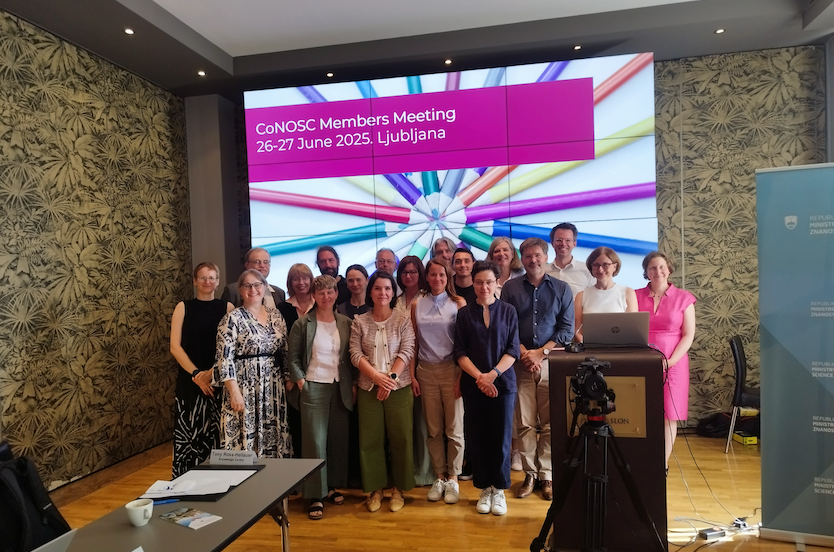CoNOSC addresses OS impact, AI, and resiliency of Open Science policies

CoNOSC Meeting June 2025” photo, by Maja Peharc, is licensed with a CC BY licence
On 26-27 June 2025, thirteen countries attended the CoNOSC face-to-face meeting in Ljubljana, hosted by the Slovenian Ministry for Higher Education, Science, and Innovation. Over two days, participants explored the impact of Open Science, its intersections with AI, and strategies to build resilient and trustworthy open research ecosystems.
What drives open science impact?
Nicki Lisa Cole (Senior Researcher, Know Center Research GmbH) addressed how to measure the impact of Open Science. She highlighted studies that demonstrate how open science makes research more academically, economically, and societally impactful. Examples include COVID-19 open artefacts, ELIXIR Bioinformatics, and national repositories in France, Portugal and the Netherlands. Impact refers to the long-lasting change that arises from research results being more openly accessible, empowering researchers and society.
Although evidence of what drives Open Science impact is still emerging, we know that Open Access and wider participation in research lead to increased efficiency and productivity. Likewise, national open science repositories lead to impact and clear economic benefits.
Cole shared the PathOS project’s recommendations:
- Increase national and institutional support for Open Science impact studies
- Gather data on understudied open science interventions
- Identify what to monitor about Open Science and why
- Align the assessment of Open Science impact with institutions
- Celebrate Open Science practices proven to drive impact.
Open science impact stories
In the breakout session, members shared impact stories that work well with Open Science policy decision makers. Many examples were collected, including for medical research (the Human Genome Project or COVID-19 vaccines), widening access to knowledge (Wikipedia), and creating more efficiency and transparency in research (Ten Years Reproducibility Challenge). Participants agreed that having multiple impact narratives is key.
Members also discussed areas where more evidence or indicators of expected impact are needed. Open Science boosts emerging research themes, enhances collaboration, facilitates economic growth and competitiveness, and, paired with robust research security measures, fosters a trustworthy research ecosystem. The return on investment in Open Science is not always monetary, but also societal. Open Science policy must work to restore the social contract between research and society.
Harnessing AI while protecting open science values
Tony Ross-Hellauer (Leader of the Open & Reproducible Research Group, Know Center Research GmbH) outlined the risks and opportunities AI poses for Open Science. AI can compromise scientific reproducibility, requires new standards for data and metadata, can function with bias and without transparency, and can generate synthetic or misleading content. It also raises important questions/concerns about equity and sustainability. He recommended Open Science advocates monitor AI, keep stakeholders knowledgeable, and mitigate risks of misinformation and misuse of open content by AI tools.
There are potential AI benefits for Open Science if approached cautiously, such as collaborative infrastructures that responsibly integrate AI and Open Science. For example, AI can boost Open Science advocacy, open up knowledge, accelerate research, and help facilitate meaningful access to diverse scientific content. It can also provide translations or recommend systems that support information filtering or even help in the creation of data management plans.
Opportunities and threats of AI
The most critical challenge that Open Science researchers and policymakers perceive is to use AI responsibly. A dedicated breakout session underlined that communicating on this topic effectively is a skill that policymakers need. Policymakers should ensure that AI developments align with and reinforce Open Science principles. The values behind Open Science should be used in policy and research to rein in untrustworthy AI practices. Funding can go toward developing tools that apply AI responsibly, such as automating administrative processes in data management plans. Policymakers could prompt institutions to ensure reliable and open AI tools are available for the public good. They should consider how to empower the research community to share evidence-informed insights about AI regulation and promote these insights amongst policymakers and politicians.
Resilient open research
The keynote by Peter Suber (Senior Adviser on Open Access, and Director of the Harvard Open Access Project, Harvard University) focused on lessons learnt from current U.S. changes in access to information, and increased intervention in certain areas where some research data is being lost or no longer collected. He reflected on the role of Open Science in making science more resilient. Engaging the community in preserving research and data—such as by ensuring multiple copies are stored in diverse locations, including internationally—is vital. In summary, infrastructure ownership should be clear, and Open Access research should be hosted uncensored, with shared and balanced governance, for it to remain an available, free, neutral, and objective source of knowledge.
Conclusion
Discussion at the Ljubljana meeting emphasised that strengthening the evidence of Open Science’s impact, ensuring policy acts to align AI developments with open values, and safeguarding knowledge against political disruption are essential for the future of Open Science. These timely priorities highlight the need for compelling narratives that communicate powerfully on the benefits of Open Science, of responsible AI handling in research policy, and emphasise the central role of openness in building a resilient and trustworthy research ecosystem.